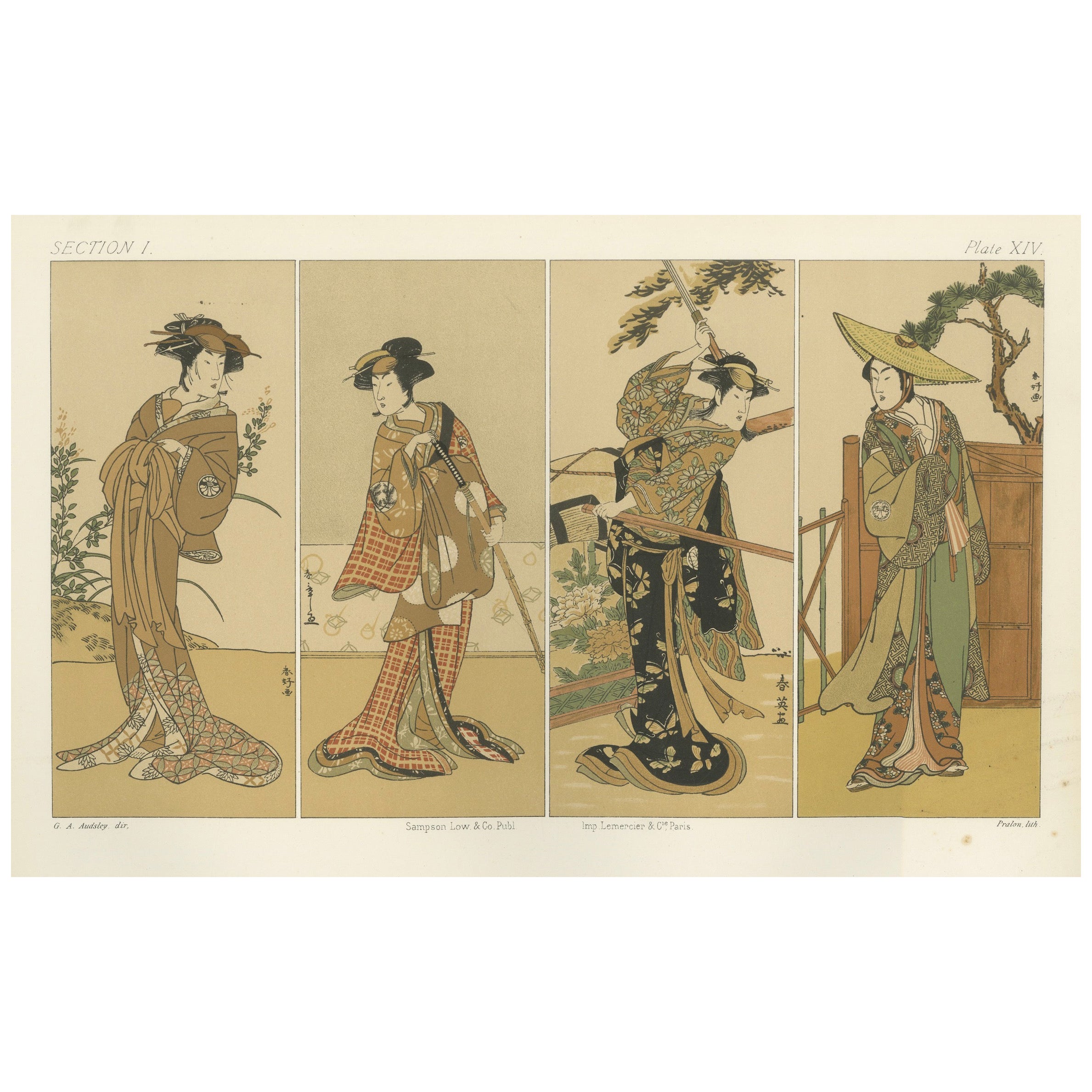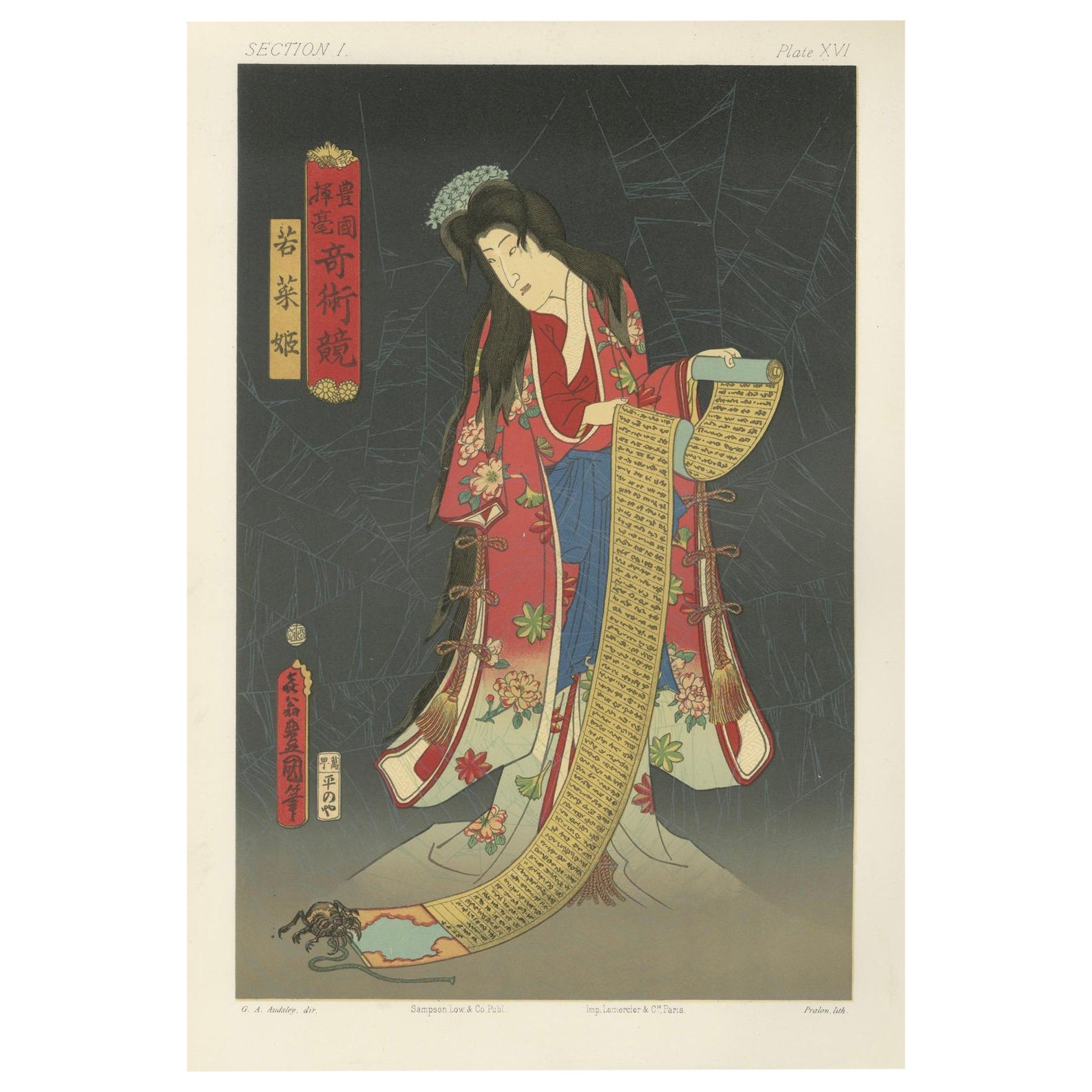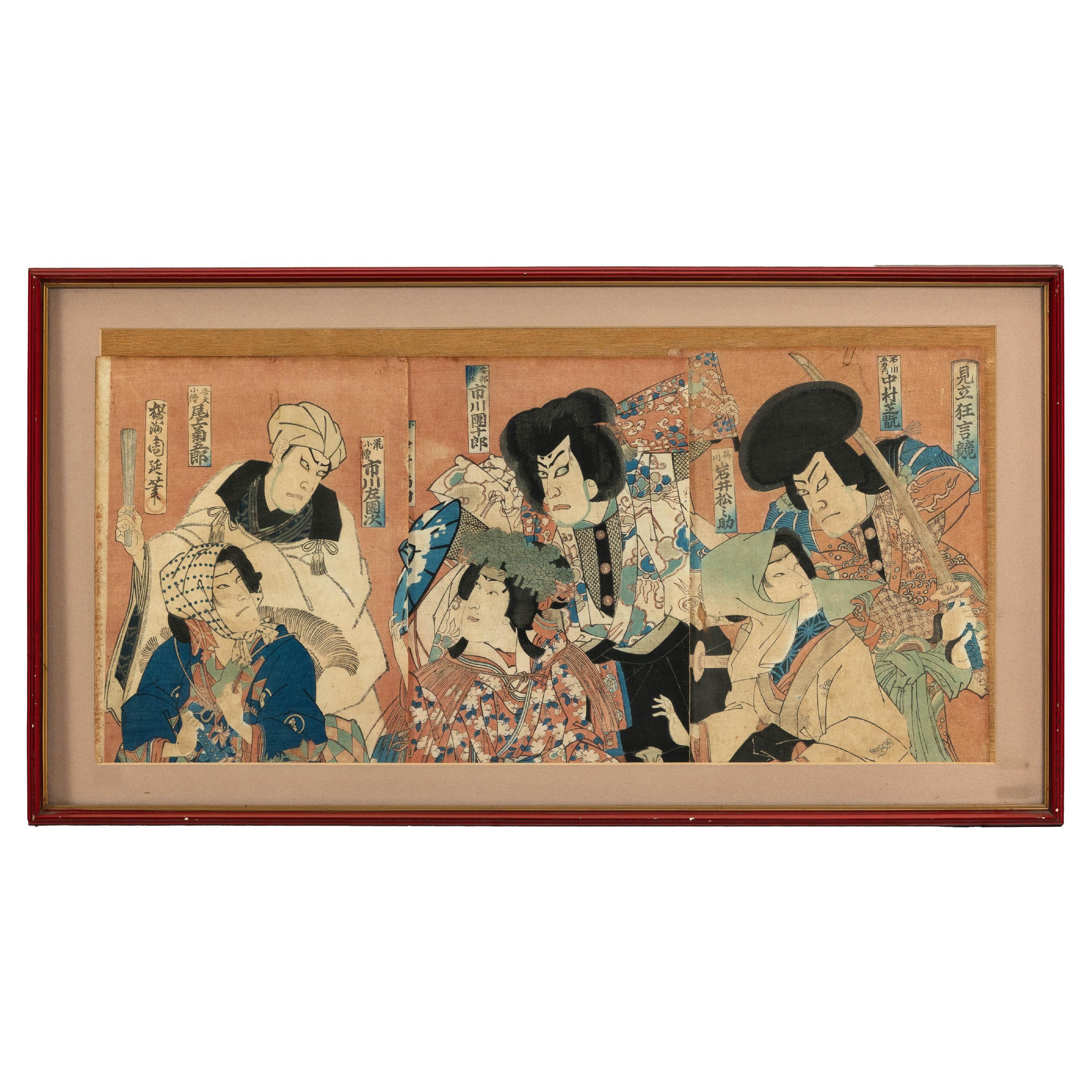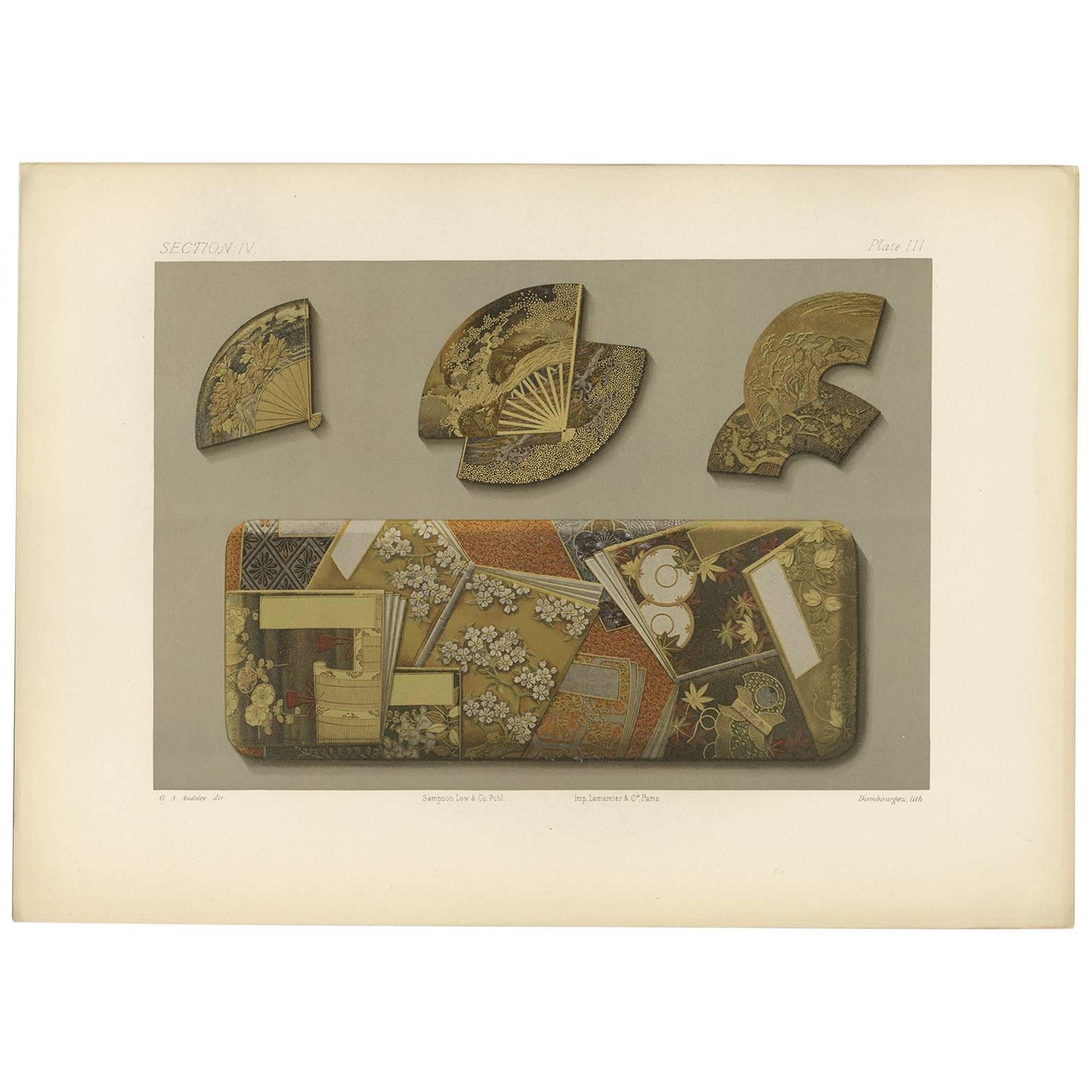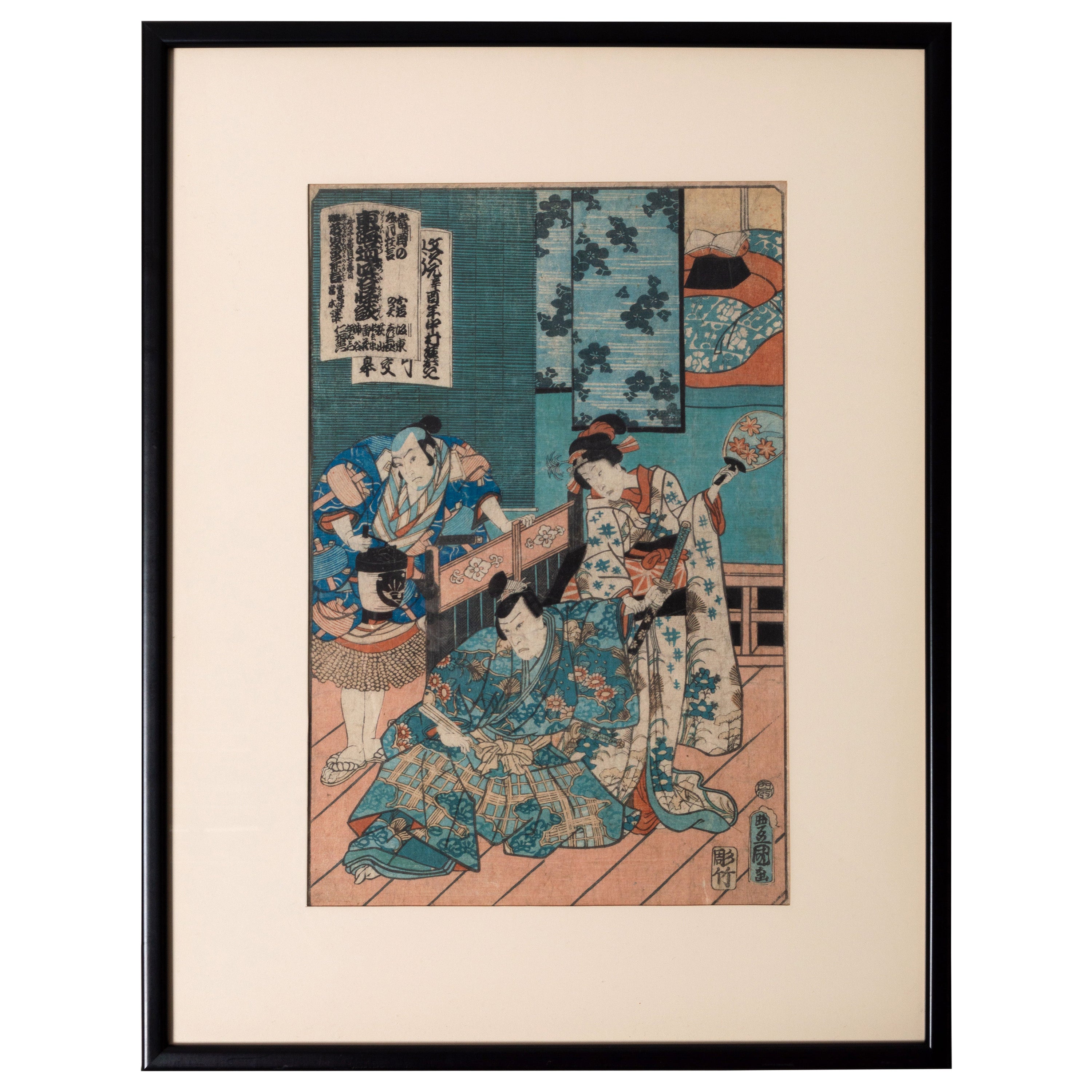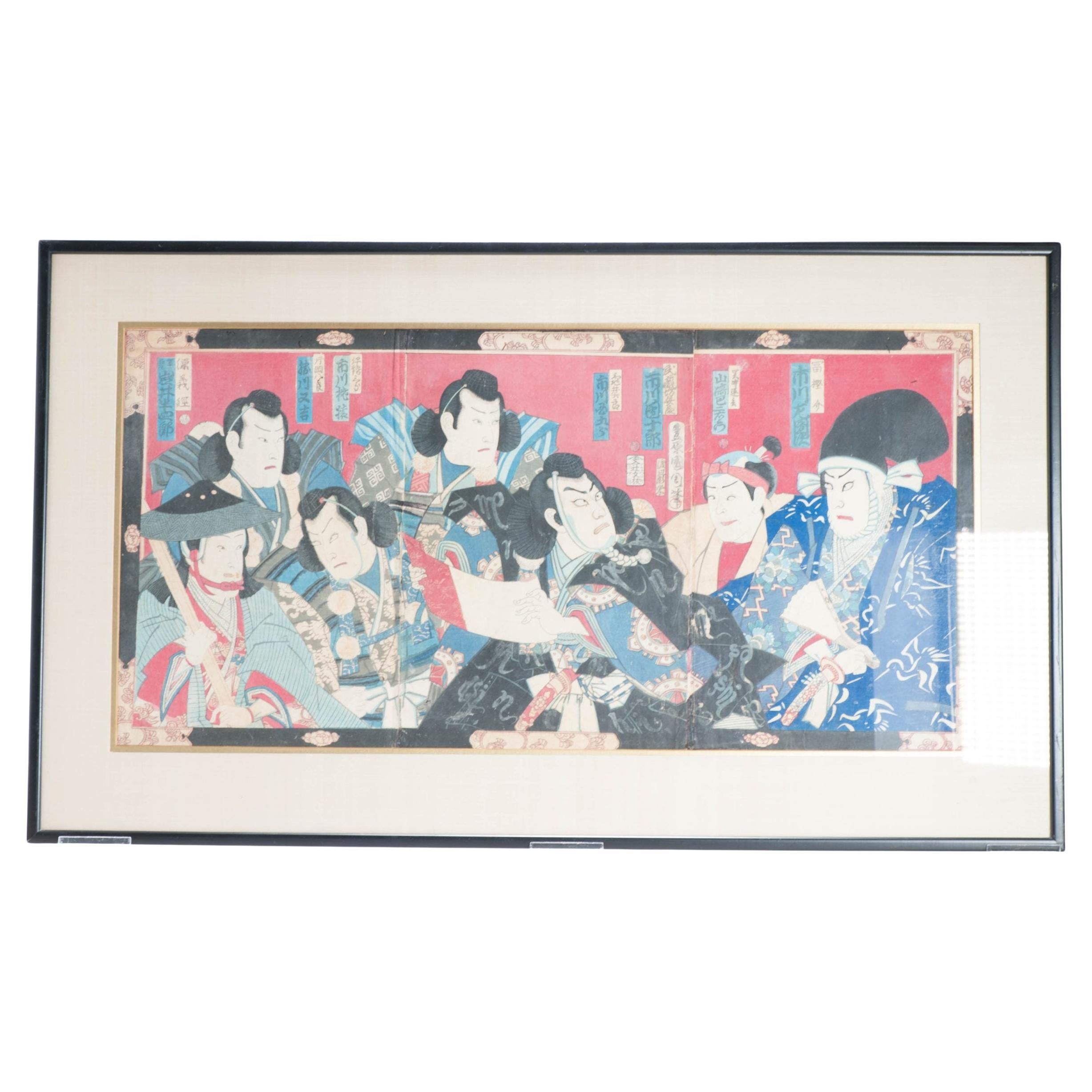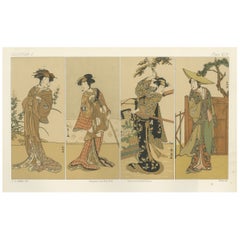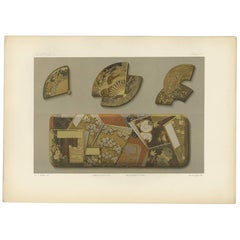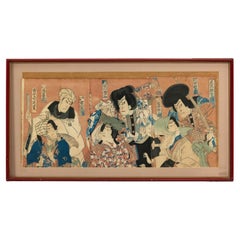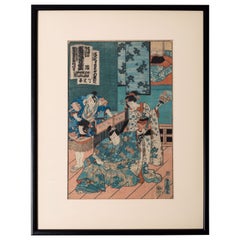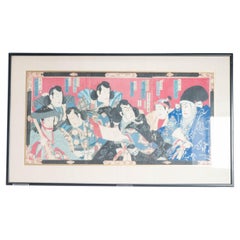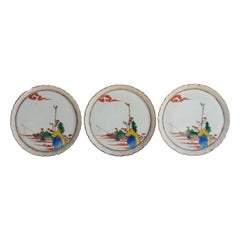Articles similaires à Antique Japanese Actor Portraits: Four Kabuki Figures in Edo-Period Style, 1882
Vous voulez plus d'images ou de vidéos ?
Demander au vendeur plus d'images ou de vidéos
1 sur 10
Antique Japanese Actor Portraits: Four Kabuki Figures in Edo-Period Style, 1882
À propos de cet article
Title:
Antique Japanese Actor Portraits: Four Kabuki Figures in Edo-Period Style
Description:
This 19th-century Japanese print features four dignified male figures, each dressed in elaborate Edo-period attire and rendered with striking clarity and grace. Published by Sampson Low & Co. and lithographed in Paris by Imp. Lemercier & Cie, the work was directed by G. A. Audsley, a noted champion of Japanese art in the West. These men are likely kabuki actors depicted in various roles, reflecting the rich tradition of theater in Edo-period Japan.
The prints capture the elegance and power of kabuki performance, where actors wore sumptuously patterned kimono that conveyed status and character. Each figure is carefully posed against a minimalist background, which allows the subtle details of their costumes to shine: geometric motifs, floral patterns, and luxurious fabrics that symbolize refinement and cultural sophistication. These garments not only highlight the wealth and social standing of the figures but also communicate layers of meaning through pattern and color.
The restrained palette of muted greens, golds, and deep blacks lends a timeless quality to the prints, while the distinctive hairstyles and facial expressions suggest the theatrical intensity of kabuki drama. Whether wielding a staff, holding a container, or standing in quiet contemplation, these figures offer a glimpse into the world of Edo-period performance, where art and life seamlessly intertwined.
Collectors of Japanese art or those interested in the history of kabuki theater will find this print a striking addition to their collection, offering a window into the rich tapestry of Edo cultural life.
The connection between kabuki theater and the vivid visual language of these prints:
Kabuki, an iconic form of Japanese theater that emerged in the early 17th century, is renowned for its stylized performances, elaborate costumes, and powerful storytelling. It played a key role in Edo-period entertainment, and its themes—ranging from historical epics to romantic tales and supernatural legends—reflected the values, anxieties, and dreams of the time.
Actors in kabuki performances were often depicted in woodblock prints known as yakusha-e (actor pictures). These prints, like the one you’re listing, allowed fans and collectors to bring home the larger-than-life presence of their favorite performers. The images captured not only the appearance of the actors but also the essence of the roles they played, immortalizing moments of intense drama and elegant beauty.
The clothing of these figures carries significant symbolic weight. The bold geometric patterns and luxurious fabrics, seen in the prints, were part of the elaborate stage presence that set kabuki apart from other theatrical forms. Specific patterns, such as tortoiseshell, cranes, or pine trees, signified longevity, strength, and auspicious fortune—qualities highly prized in Edo society. Even the manner in which a kimono was worn or tied could indicate the character’s social class, age, or moral standing.
These four dignified figures also illustrate the subtle artistry of the kabuki actor—conveying complex emotions through controlled posture, refined gesture, and expressive facial features. In the prints, their calm intensity and careful staging mirror the poise and ritual of kabuki performances, blending the ephemeral nature of theater with the enduring artistry of printmaking.
By adding this context to your listing, you not only highlight the refined craftsmanship of the piece but also its deep cultural resonance, offering potential buyers an opportunity to own a fragment of Japan’s rich theatrical heritage.
Condition Report:
This print is in very good condition, with only minor foxing and slight toning at the margins. The colors remain rich and the linework crisp, preserving the refined artistry of this piece.
Framing Tips:
A simple dark wood or black lacquer frame with a white or cream mat will complement the elegant color scheme and focus attention on the intricate patterns of the kimono and the dignified bearing of these figures.
- Dimensions:Hauteur : 27,5 cm (10,83 po)Largeur : 40 cm (15,75 po)Profondeur : 0,2 mm (0,01 po)
- Matériaux et techniques:
- Période:
- Date de fabrication:circa 1882
- État:This print is in very good condition, with only minor foxing and slight toning at the margins. The colors remain rich and the linework crisp, preserving the refined artistry of this piece.
- Adresse du vendeur:Langweer, NL
- Numéro de référence:Vendeur : BG-14034-1-201stDibs : LU3054345212162
À propos du vendeur
5,0
Vendeur reconnu
Ces vendeurs prestigieux sont des leaders du secteur. Ils représentent le summum en matière de qualité et de design.
Vendeur Platine
Vendeurs premium dont la note est supérieure à 4,7 et le délai de réponse de 24 heures maximum
Établi en 2009
Vendeur 1stDibs depuis 2017
2 442 ventes sur 1stDibs
Temps de réponse habituel : 1 heure
- ExpéditionRecherche du devis...Expédition depuis : Langweer, Pays-Bas
- Politique des retours
Certaines parties de cette page ont été traduites automatiquement. 1stDibs ne garantit pas l'exactitude des traductions. L'anglais est la langue par défaut de ce site web.
Garantie d'authenticité
Bien qu'il soit peu probable que la situation se présente, dans le cas où vous rencontreriez un problème d'authenticité d'un article, contactez-nous dans un délai d'un an pour obtenir un remboursement intégral. DétailsGarantie de remboursement
Si votre article n'est pas conforme à la description, est endommagé pendant le transport ou ne vous est pas livré, contactez-nous sous 7 jours pour obtenir un remboursement intégral. DétailsAnnulation sous 24 heures
Vous disposez d'un délai de 24 heures pour annuler votre achat sans motif.Des vendeurs professionnels agréés
Nos vendeurs de renommée mondiale doivent respecter des normes strictes en matière de service et de qualité, afin de préserver l'intégrité de nos fiches produit.Garantie d'alignement des prix
Si vous constatez qu'un autre vendeur a mis en vente le même article à un prix inférieur sur un autre site, nous nous alignerons sur ce prix.Livraison en toute confiance à l'international
Notre réseau de transporteurs de premier ordre propose des options d'expédition spécialisées dans le monde entier, y compris des livraisons personnalisées.Plus d'articles de ce vendeur
Tout afficherAntique Japanese Costume Print: Four Elegant Women in Edo-Period Kimono, 1882
Antique Japanese Costume Print: Four Elegant Women in Edo-Period Kimono
This refined 19th-century Japanese print features four beautifully dressed women in elegant kimono, each capt...
Catégorie
Antiquités, années 1880, Estampes
Matériaux
Papier
Antique Japanese Kabuki Print: Enigmatic Woman with Scroll and Spider, ca.1882
Title: Antique Japanese Kabuki Print: Enigmatic Woman with Scroll and Spider, 19th Century
Description: This stunning 19th-century Japanese print depicts a striking scene from kabuk...
Catégorie
Antiquités, années 1880, Estampes
Matériaux
Papier
Impression ancienne de quatre boîtes japonaises en laque par G. Audsley, 1882
Par George Ashdown Audsley
Épreuve sans titre, section IV, plaque III. Cette chromolithographie représente quatre boîtes japonaises différentes. Des informations détaillées sur ce tirage sont disponibles sur d...
Catégorie
Antiquités, Fin du XVIIIe siècle, Estampes
Matériaux
Papier
277 $US Prix de vente
20 % de remise
Impression ancienne de la tapisserie 'Japan' par G. Audsley, 1882
Par George Ashdown Audsley
Épreuve sans titre, section III, planche VI. Cette chromolithographie représente une tapisserie faite à la main, travaillée avec des fils de chaîne de soie et d'or étroitement torsad...
Catégorie
Antiquités, Fin du XVIIIe siècle, Estampes
Matériaux
Papier
277 $US Prix de vente
20 % de remise
Japanese Geisha Portrait Print: Vibrant Kimono and Serene Poise, c.1882
Title:
Japanese Geisha Portrait Print: Vibrant Kimono and Serene Poise
Description:
This captivating Japanese print is a masterful example of traditional artistry, depicting a seren...
Catégorie
Antiquités, années 1880, Estampes
Matériaux
Papier
Lithographie ancienne de la course des Mongoles - Japonaise, 1882
Découvrez un aperçu captivant du monde de l'ethnographie du XIXe siècle avec la "Race mongole - japonaise", une gravure ancienne tirée du Comprehensive Atlas and Geography de Blackie...
Catégorie
Antiquités, années 1880, Estampes
Matériaux
Papier
175 $US Prix de vente
20 % de remise
Suggestions
Impression triptyque japonaise Kabuki encadrée avec acteurs samouraïs et couronnes
Un triptyque japonais ukiyo-e, cette gravure sur bois encadrée du théâtre Kabuki capture l'énergie et le drame des spectacles de la période Edo. La scène se déroule sur trois panneau...
Catégorie
Antiquités, Fin du XIXe siècle, Japonais, Meiji, Estampes
Matériaux
Verre, Bois, Peinture, Papier
Impression sur bois japonaise encadrée du 19ème siècle représentant des acteurs Kabuki Toyokuni III
Gravure sur bois japonaise du 19ème siècle d'acteurs de Kabuki Toyokuni III
Gravure sur bois originale de Toyokuni III (1786 - 1864)
Des acteurs de Kabuki Bando Hikosaburo et Nizae...
Catégorie
Antiquités, XIXe siècle, Japonais, Estampes
Matériaux
Papier
Impression sur bois ancienne de Toyohara Kunichika, acteurs Kabuki Nagayoshi Hokoma
Par Toyohara Kunichika
Toyohara Kunichika (1835 - 1900)
Informations complémentaires :
Matériau : Papier
Région d'origine : Japon
Période : XIXe siècle
Type de décoration / Couleur:Polychrome
Condit : Bon...
Catégorie
Antiquités, XIXe siècle, Japonais, Estampes
Matériaux
Papier
Ensemble de 3 plats anciens en porcelaine japonaise de la période Kutani Edo, Japon, 18/19e siècle
Un très bel ensemble de 3 plats polychromes de forme moulée. Forme et peinture inhabituelles.
Période Edo.
Informations complémentaires :
MATERIAL : Porcelaine et poterie
Style jap...
Catégorie
Antiquités, 17ème siècle, Japonais, Edo, Estampes
Matériaux
Porcelaine
Bloc de bois japonais ancien - acteurs - Utagawa Kuniyoshi japonais, 1797-1861
Description
Acteurs : Hotei Ichiemon et Gokuin Chiemon
Date :
c. 1847/52
Artiste :
Utagawa Kuniyoshi
Japonais, 1797-1861
Artistics
Utagawa Kuniyoshi
Titre
Acteurs : Hotei Ichiem...
Catégorie
Antiquités, XIXe siècle, Japonais, Edo, Estampes
Matériaux
Papier
Toyokuni japonais ancien Calligrphy Edo ou Meiji
Un très beau bloc imprimé par Tokoyuni dans les années 1850
10-9-18-rof-301
Informations complémentaires :
Type : Peintures, rouleaux et gravures
Région d'origine : Japon
Pays de f...
Catégorie
Antiquités, XIXe siècle, Japonais, Estampes
Matériaux
Papier
310 $US Prix de vente
20 % de remise
